Palestine Diary: Where the Gaza Genocide Is Just the Tip of the Iceberg
This is the first Palestine Diary. Read the second here.
Hindus for Human Rights has been an active participant in the mass movement calling for a ceasefire, an arms embargo and an end to Israel’s occupation of Palestine. We see common cause with anti-Zionist Jews because we too are fighting the extremists of our faith — including India’s Hindu supremacist government, which has sent arms to support Israel’s genocide on Gaza. When Rabbis for Ceasefire invited us to join them in an interfaith peace delegation to Palestine, we readily agreed. This would be a chance to meet people suffering the brunt of this brutality, and to look them in the eyes and tell them the world cares.
There were meant to be two Hindus on this interfaith peace delegation to Palestine, but my colleague Rajiv Sinha, the director of HfHR-UK, was denied entry. He was detained and harassed by border security for over five hours along with several Palestinians. Rajiv was traveling to Palestine to protest the genocide that has been underway for the past ten months, but got a bitter taste of what ordinary daily life has been for Palestinians for the past seven decades.
I arrived on Janmashtami, and have been here in the West Bank for five days. The delegation is 35 strong: Jews, Muslims, Christians, and one Buddhist, Maung Zarni, the renowned Burmese genocide scholar Maung Zarni. There has been an escalation during our time here: Israel began a “Gaza style” invasion of the Northern West Bank, killing 9 people in Jenin yesterday. We have had to adjust accordingly, staying away from the North, but we have managed to have very packed days. Sabeel, the Palestinian NGO that has organised our itinerary, has helped us connect with a number of brave Palestinians trying to survive in this cruel apartheid state. Every single encounter has brought into clearer view the fact that the current genocide in Gaza, as horrific as it is, is the tip of the iceberg.
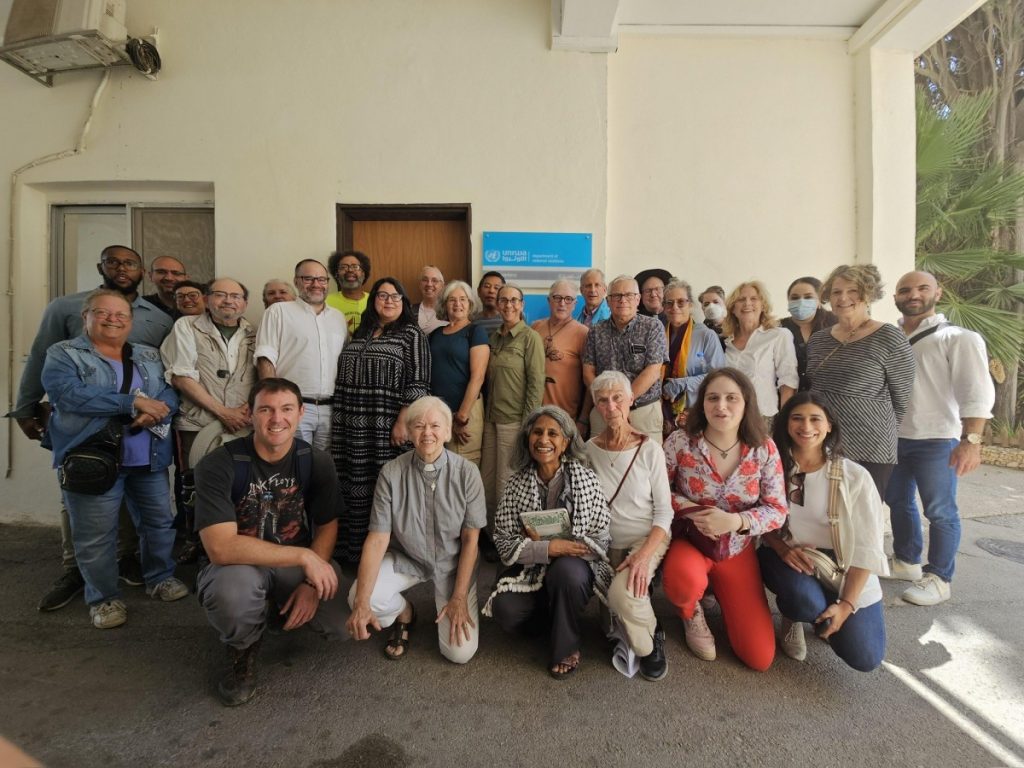
Entire delegation at UNRWA headquarters meeting. Photo: Sunita Viswanath.
August 27: Shufat Refugee Camp
As we walked from our bus to the Shufat refugee camp in East Jerusalem, we could see to our right the upscale French Hills Settlement, an illegal Israeli settlement built on a hill where Palestinian homes had been bulldozed. On our left stood the tall, gray concrete wall between Israel and Palestine that enforces apartheid. The wall is stark and ugly, like that of a prison. But as we turned the corner and entered the camp, we saw that the inside of the wall had been painted with murals of cottages and gardens and blue skies.
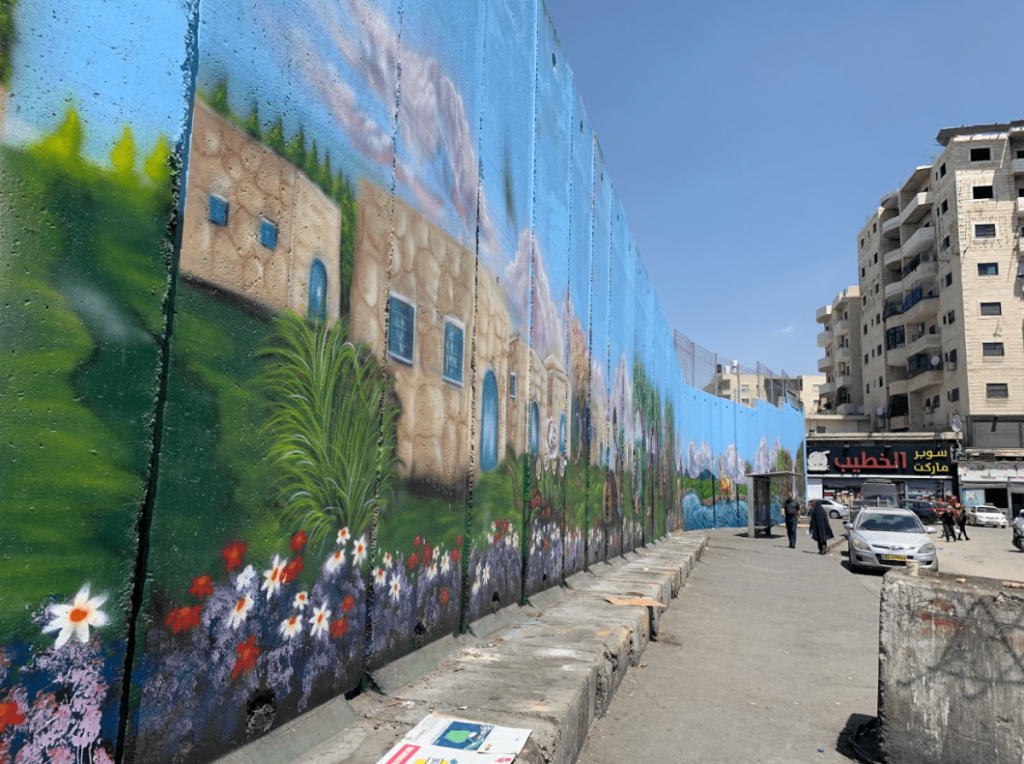
The mural at the camp. Photo: Sunita Viswanath.
A little boy called Mohammed told us that almost every day, the soldiers come and release tear gas throughout the camp, Sometimes they shoot bullets. We could see one wall of the UNRWA school in the refugee camp riddled with bullets (below).
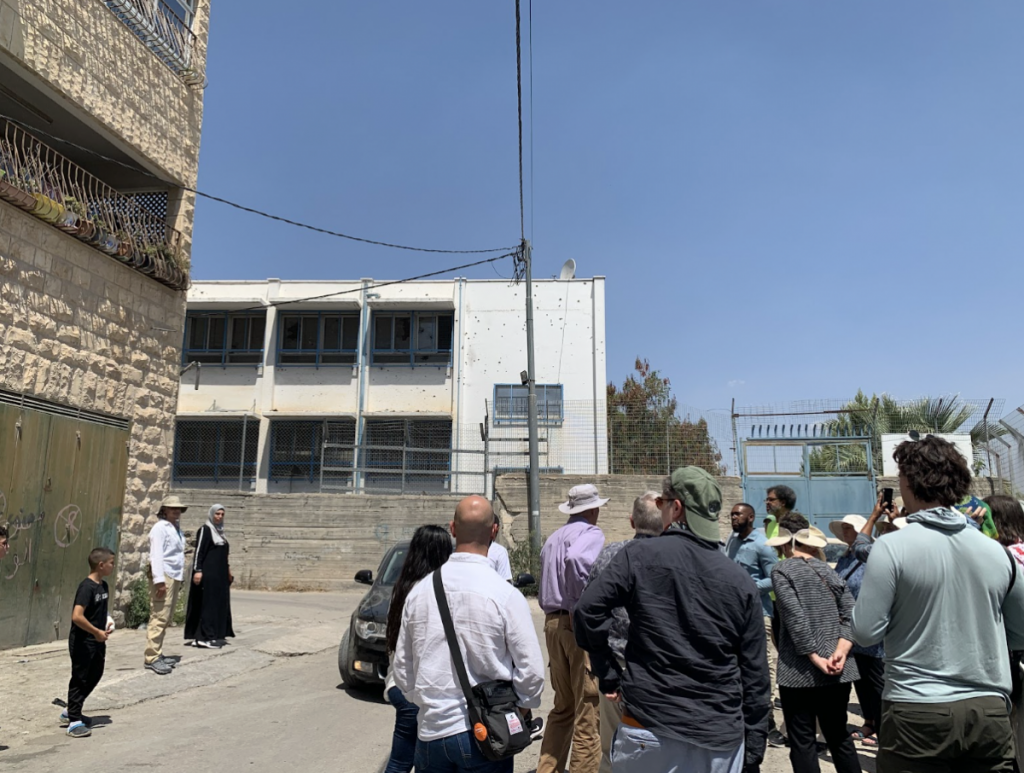
Photo: Sunita Viswanath.
The next day, someone in the refugee camp sent Omar, our guide and host, videos and photos of soldiers filing into Shufat Camp, and clouds of tear gas being released. This is everyday life in Palestine.
August 27: Silwan
Silwan is an old Palestinian neighbourhood in East Jerusalem that is rapidly being taken over by Israeli settlers. As we walked along the road leading to Fakhri Abu Diab’s home, we saw many more luxurious homes that must have been built on demolished Palestinian homes. Fakhri’s family had been receiving threats of demolition for many years. They were told the property was illegal, and the authorities refused to give them the documents which would prove their ownership. Fakhri is a well-connected community leader, and American politicians and dignitaries often visit his home when they come to Jerusalem. But his connections did not help his family avert the inevitable.
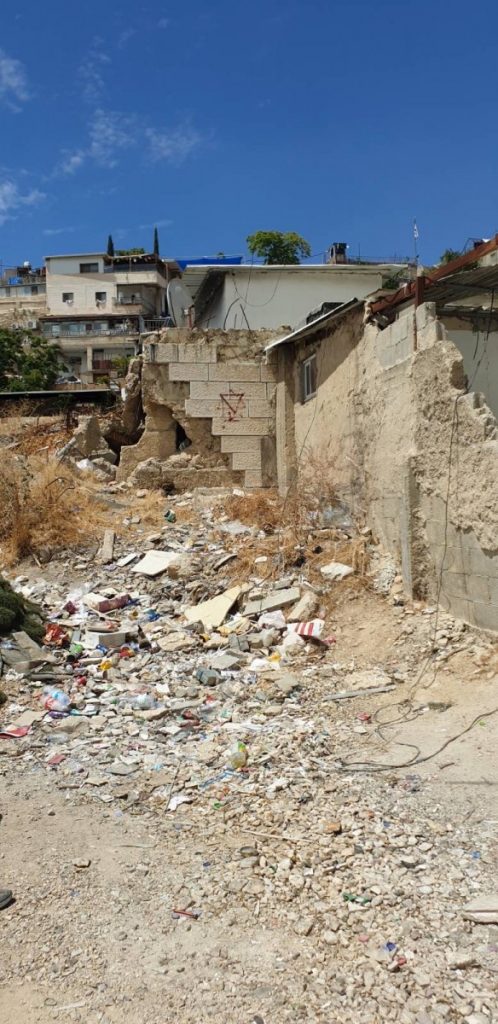
The Star of David on a destroyed house. Photo: Sunita Viswanath.
Last year Anthony Blinken’s representative had visited Fakhri’s home and promised him that the house would not be demolished — he would make sure. In February, without notice, the bulldozers arrived and did their dirty job. This was a beautiful old house where Fakhri had been born, and where his children were born too. Fakhri almost wept telling the story. To add insult to injury, settlers ask Palestinians to demolish their own homes, and many do. Fakhri and his family are beginning to rebuild their home, and prepared a meal for our delegation in their newly rebuilt kitchen. They know that they are not allowed to rebuild, and the renovations could be demolished at any time. They rebuild anyway. They are fighting the case in court. This is the survival spirit of Palestine.
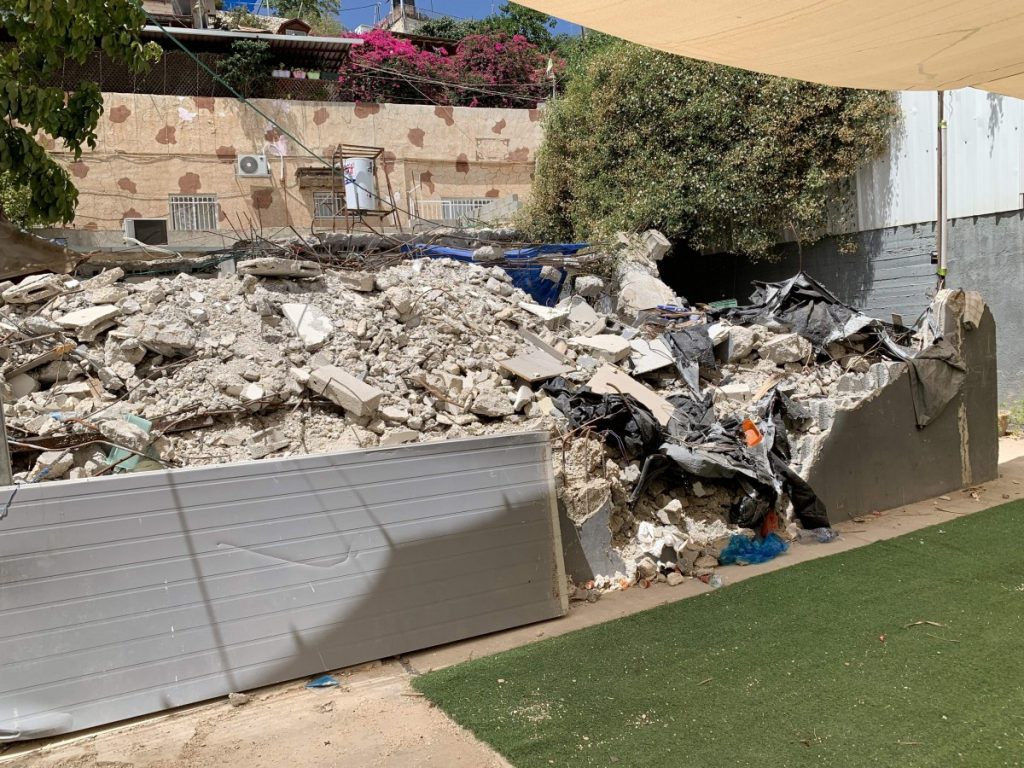
Demolished house. Photo: Sunita Viswanath.
August 28: Al-Makhrur, West of Bethlehem
In a breathtaking area on the side of a mountain, Israeli settlers have been making life hell for the Kassieh family. Alice Kassieh, along with her mother, brother, sister-in-law, and the rest of their family, cannot leave their land unattended, else the settlers who have set their hearts on this particular property will simply come and take it. Alice’s sister-in-law has done everything to leverage her American citizenship, but her pleas have fallen on deaf ears.
The settlers have physically attacked members of the family, male and female, then filed police complaints saying the family attacked them. The family is building global support on social media and a vibrant grassroots movement on the land. They have built a large tent for meetings, festivals, and other actions. They refuse to give up their land.
August 28: Carmel Settlement
Two hours from Jerusalem, in the South Hebron Hills, is an area called Masafar Yatta, home to twelve Palestinian villages with 2,800 residents. The Israeli army has been systematically seizing land here, demolishing homes, building new homes and other facilities, and blocking off settlements with massive gates and checkpoints. One such village is Umm Al Khair.
We were greeted by Eid and Audi, brothers and village leaders, a herd of sheep, and a playground full of children. The houses, community center, library and other buildings were forcefully bulldozed, but they keep building again. They recently built the colorfulul playground we met in.
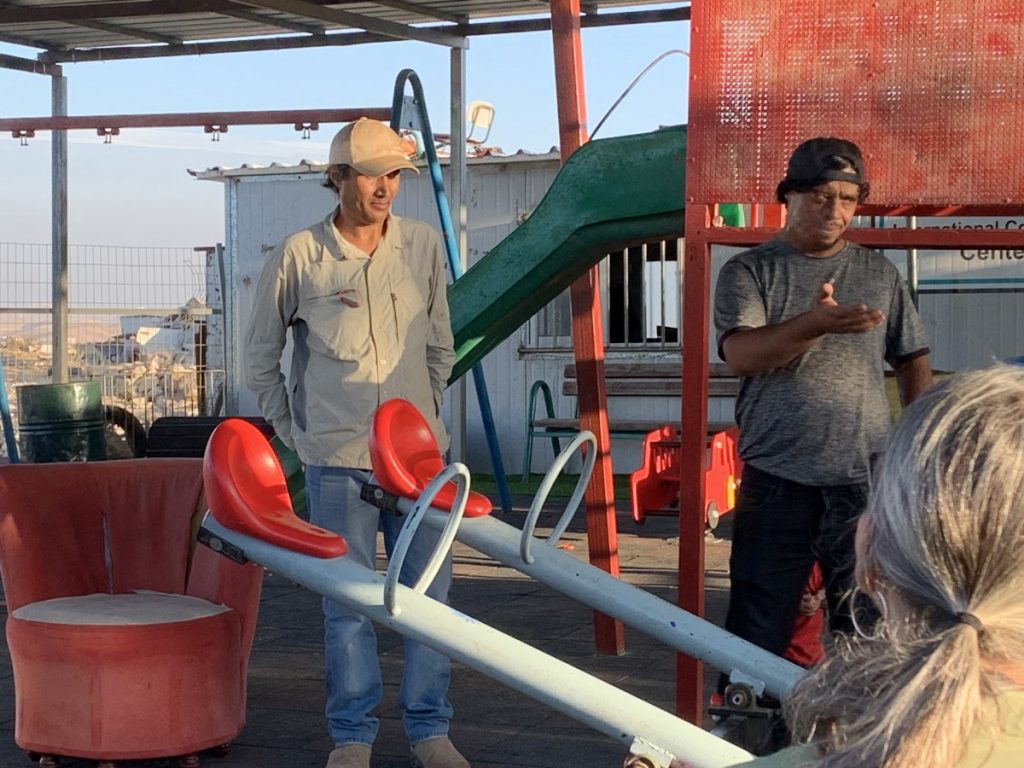
Eid and Audi address our delegation. Photo: Sunita Viswanath.
On a hill just opposite, we saw new houses with cars and gardens. That was Carmel Settlement, we were told. It was encircling them. We were asked not to go too close to a yellow gate with the Israeli flag on it, because the settlers are armed, as are the soldiers. Electricity lines ran right over the village, leading to a chicken factory farm just outside its borders. Eid said the chickens have electricity and air conditioning, while the villagers don’t even have water. They’ve managed to install solar panels, though, and are generating enough electricity to serve their needs. We could all hop on to their village WiFi. They welcome activists and volunteers and will put them up for a few days. They are building a network of supporters around the world, and send out regular newsletter updates. They are fighting legal cases and seem hopeful about winning them. They can’t lose hope, Eid said, for the sake of their children.
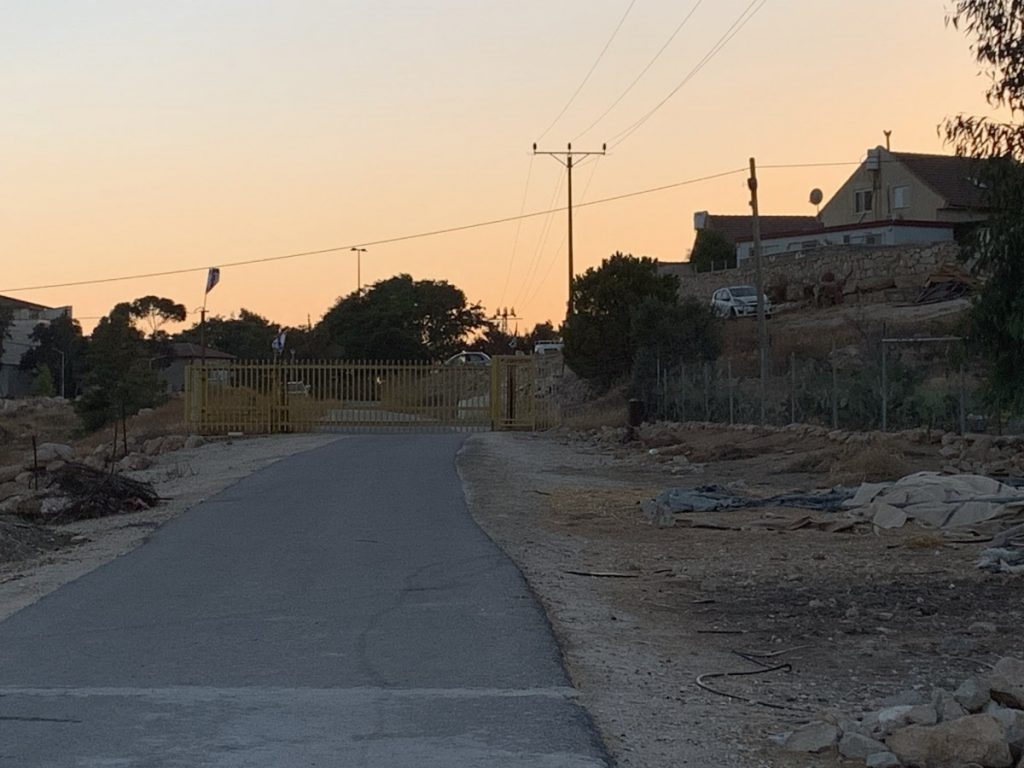
Carmel Settlement. Photo: Sunita Viswanath.
August 29: Gaza-Rafah Border
This spirit of resistance and resilience has surrounded us the whole week. We could not allow ourselves to be scared or depressed while meeting such fighters. But today was a day where we gave in to the grief and horror which brought us here.
We drove down to the border of Rafah. For the last hour or so, we could see Gaza in the distance, just a few miles away. Every so often, an air strike would make a massive gray cloud. The Gaza border was basically a massive empty parking lot. We thought it would be full of trucks with humanitarian aid waiting to get across, but we only saw two during the couple of hours we were there. We saw more military vehicles and tanks than UN trucks.
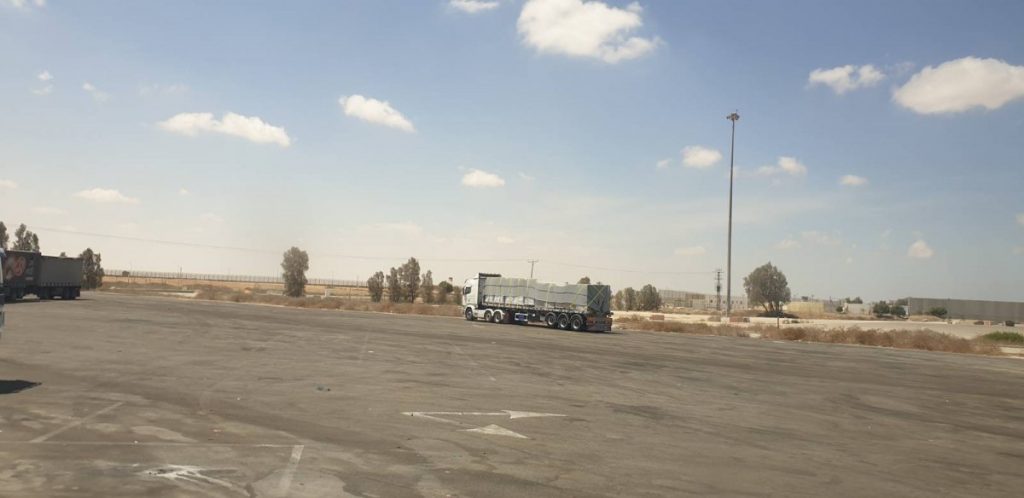
The bleak and empty border crossing. Photo: Sunita Viswanath.
We formed a large semi-circle and took turns sharing prayers from our various faiths. I prayed to Lord Krishna to preserve what goodness and kindness is left in us, and to Lord Shiva to destroy the evil behind this atrocity. And I lamented the fact that I was thrice complicit: All three countries I have called home – India, England and the United States – are actively supporting this genocide.
We cried, prayed and raged for an end to the bombs and an arms embargo. We cried, prayed and raged for Gaza.
Today we weep. Tomorrow we fight.
Sunita Viswanath is Executive Director, Hindus for Human Rights.
This article went live on August thirtieth, two thousand twenty four, at thirteen minutes past eleven in the morning.The Wire is now on WhatsApp. Follow our channel for sharp analysis and opinions on the latest developments.




